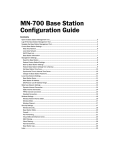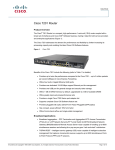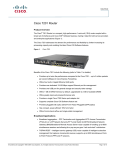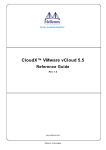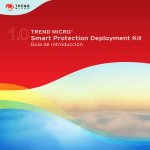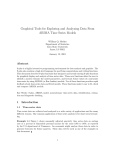Download Alcatel-Lucent 5750 SSC User's Manual
Transcript
Alcatel-Lucent 5750 Subscriber Services Controller Integrated Subscriber and Services Control for Alcatel-Lucent’s Triple Play Service Delivery Architecture The Alcatel-Lucent 5750 Subscriber Services Controller (SSC) is a flexible, modular and preintegrated subscriber- and policy-management solution that controls Alcatel-Lucent’s Triple Play Service Delivery Architecture (TPSDA), enabling innovative IMS (IP multimedia subsystem) and non-IMS services to be dynamically created on an IP infrastructure capable of delivering different quality of service (QoS) levels. The Alcatel-Lucent 5750 SSC is instrumental in cost-effectively delivering next-generation IP-based services such as broadcast IP television (IPTV), video on demand (VoD), voice over IP (VoIP), enhanced Internet services (EIS) and emerging IMS services to a mass market, while enabling a personalized and seamless user experience across all bundled services. 2 Alcatel-Lucent 5750 Subscriber Services Controller On-demand subscriber self-service portals and network-policy autogeneration allow service providers to minimize operational costs by employ ing a flexible, “zero-touch” service-delivery model that caters to individual subscriber preferences and evolving service needs. The Alcatel-Lucent 5750 SSC reduces operational transformation risks and the costs of introducing new network architecture and services. Its modularity and flexibility enable deployment in phases, allowing service providers to satisfy initial service-deployment requirements while investing in a future-safe platform that can be leveraged to scale VoD, migrate toward IMS, support emergency systems for IP telephony, introduce mandatory law systems for Internet service, etc. The Alcatel-Lucent 5750 SSC also provides a graceful subscriber migration from best-effort services delivered using the legacy broadband remote access server (BRAS) network to EIS on the Alcatel-Lucent TPSDA. The Alcatel-Lucent 5750 SSC removes the need to duplicate back-office systems by centralizing subscriber and policy management for both TPSDA and the legacy BRAS on one platform. Modularity and proxy functions also minimize legacy-network configuration changes and enable a smooth transition to centralized operations. Alcatel-Lucent 5750 Subscriber Services Controller 3 Challenges and Opportunities of Triple-Play Service Delivery Triple-play service delivery — blending voice, video and data services in an integrated service bundle — is a generational leap that carries with it certain challenges. • Today’s Internet service-delivery networks are optimized for flat-rate, best-effort commodity services. With the advent of triple play, high-revenue services such as interactive multimedia applications, VoIP, VoD and broadcast TV (BTV) become the dominant networkdesign drivers. These services place unprecedented scalability, reliability, flexibility and QoS requirements on the IP-network infrastructure. • New user devices such as residential gateways (RGs), IPTV set-top boxes, IP phones and gaming consoles are being introduced in the digital home network and must be managed and controlled. Fiber-tothe-node (FTTN) and fiber-to-the- 4 Alcatel-Lucent 5750 Subscriber Services Controller user (FTTU) access technologies, a shift from ATM to Ethernet-based service aggregation, IP/MPLS service routing, IP multicast, and ondemand session-admission control are driving operational support requirements for which legacy systems were not designed. • While transforming to a converged, multiservice IP infrastructure, service providers need to leverage and migrate strategic assets from the installed base of TDM voice and high-speed Internet (HSI) services to effectively up-sell existing subscribers to a triple-play offering. This migration needs to be nondisruptive for the service provider and transparent to subscribers by allowing legacy service features to be seamlessly ported to the next-generation network (NGN) infrastructure while minimizing operational impacts and costs. Beyond a profound network transformation, a centralized and reliable subscriber-management and policycontrol infrastructure is required to enable millions of triple-play subscribers and end-user devices to securely access and use network-based applications, services and content with assured quality of experience. The Alcatel-Lucent 5750 SSC is purpose-built to address these needs. The system enables service providers to be optimally positioned to successfully conduct network and service transformation to converged tripleplay service delivery and unlock its full revenue potential. A Whole New World of Services The Alcatel-Lucent 5750 SSC allows service providers to increase the average revenue per user (ARPU) with the rapid creation and deployment of innovative triple-play services, enabling end users to package these services in personalized bundles. The Alcatel-Lucent 5750 SSC facilitates the introduction of new services (e.g., IPTV and VoD) and the evolution of traditional HSI services to EIS with support of dynamic bandwidth management and per-application QoS control. This allows service providers to enhance their value proposition by delivering a superior user experience for Internet video, gaming and multimedia applications. The migration of legacy voice services to NGN and the introduction of IMSbased services are other strategic areas of innovation for which the Alcatel-Lucent 5750 SSC provides an evolution path for key control elements. Figure 1 shows the key role the Alcatel-Lucent 5750 SSC plays in administering control over subscribers and user devices, application services, and network resources. Figure 1. Centralized Administration and Policy Management with the Alcatel-Lucent 5750 SSC SDM Order Entry Provisioning Assurance Billing Northbound OSS Interfaces EAP/RADIUS/DHCP Subscribers User Devices DIAMETER, XML 5750 SSC AAA, IPAM Network Access Control Dynamic Policy Control Service Admission Control Application Control Self-Care RG External AAA Servers Flexible Policy Management Framework (Subscribers, Network Resources, Service Policies) Network Interfacing (CLI, SNMP, COPS, XML/SOAP, etc.) xDSL GPON WiMAX NGN/IMS Application Servers IPTV Middleware IP/MPLS BSAN Broadband Service Access Node BSA Broadband Service Aggregator BSR Broadband Service Router Optical Core Enhanced Internet Services Triple Play Service Delivery Architecture Alcatel-Lucent 5750 Subscriber Services Controller 5 The Alcatel-Lucent 5750 SSC provides centralized management control and a data repository for: • Subscriber administration — Creation and management of subscriber accounts, user profiles and device profiles • Service administration — Creation of service profiles and triple-play services bundles • Network-policy administration — Administration and configuration of per-subscriber and per-service resource policies in the end-to-end network The flexible policy-management framework of the Alcatel-Lucent 5750 SSC uses this information for three key policy decision functions: • Network access control — Authentication, authorization and accounting (AAA) for eligible subscribers and user devices to provide access to network-based services, applications and content, with the support of 802.1x EAP, RADIUS and DHCP. The Alcatel- 6 Alcatel-Lucent 5750 Subscriber Services Controller Lucent 5750 SSC provides full flexibility to attach user devices using a range of wireline and wireless-access network technologies, with support for IP address assignment and management (IPAM) and the setting of appropriate security and QoS policies in the network. The Alcatel-Lucent 5750 SSC supports the ETSI TISPAN network attachment subsystem (NASS) specifications, providing a unified network access-control solution for both IMS and nonIMS service environments. • Dynamic service control — Dynamic application of network policies, based on various triggers such as service or change requests from customer self-service portals, network events, timer events or operations support systems (OSS) (e.g., customer care ad billing). This control allows service providers to support dynamic service or bandwidth upgrades, offer try-and-buy service specials, redirect subscribers to a captive portal in case of nonpayment or virus infection, etc. • Service admission control — Assurance that sufficient resources are available in the network to ensure proper throughput guarantees (QoS) for the duration of the session. While resources for alwayson services such as basic HSI access can be statically provisioned in the network, resource allocation for session-based services such as VoD is done dynamically for each request. The Alcatel-Lucent 5750 SSC also enables IMS-based services by supporting the ETSI TISPAN access resource and admission control function (A-RACF). Through its many open interfaces, the Alcatel-Lucent 5750 SSC coordinates and integrates information and control flows among the subscribers and user devices, OSS, applicationcontrol infrastructure, and end-to-end network to streamline operational processes associated with service delivery in real time. Service Velocity and Mass Customization Process integration and automation enable the efficient delivery of services on the massive scale that occurs in carrier networks. In the past, service providers made large investments in dedicated service-delivery tools and processes that are becoming increasingly cumbersome and costly to maintain. With the advent of triple-play service delivery and the need for ongoing service differentiation and innovation, the operational challenges of catering to the individual needs of millions of users without incurring dramatic increases in costs or processing times for customer care and support take center stage. These two issues of mass customization and service velocity require a solution that transcends traditional “cookiecutter” approaches to process integration and automation. The Alcatel-Lucent 5750 SSC brings all the interdependent control elements and aspects of triple-play service delivery together in an integrated, policy-based control solution. Using a policy-based operational model, the Alcatel-Lucent 5750 SSC enables a zero-touch operational deployment model, allowing users to choose the services and options they want and delivering them without manual intervention by customer care or support personnel. This approach provides the flexibility needed to address the following market opportunities for triple-play service delivery, combining an enriched user experience with operational cost savings and increased revenues: • Triple-play packages and tiered services — Complete, competitive and personalized service bundles that merge voice, video and data with one-stop shopping convenience and easily adapt to evolving needs. • Self-service portals — Portals that allow subscribers to directly manage their accounts and service subscriptions and temporarily or permanently upgrade service levels. This reduces customer-care costs while giving subscribers the service they want. • Application-aware QoS — The dynamic (versus static) allocation of network resources driven by user and service needs, enabling highquality video and multimedia applications and optimizing resource utilization. The Alcatel-Lucent 5750 SSC can be deployed in combination with deep packet inspection (DPI) engines to control policy enforcement of per-application QoS, security and bandwidth, and deliver EIS for secure peer-to-peer networking, online gaming and streaming Internet video and voice. • Try-and-buy, evening and weekend specials — The ability for subscribers to try services or boost service levels for a limited amount of time, or to introduce off-peak usage rates based on parameters such as usage time, traffic volume or specific content. This not only invites subscribers to try new value-added services with minimal commitment, but also encourages service usage during off-peak hours to better utilize network investments. • Comprehensive usage control and accounting — Flexible usage options and billing schemes to address different market needs using detailed subscriber-level reporting and realtime billing data. Putting subscribers in the driver’s seat — empowering them to create a more personalized and interactive experience using self-service subscription and service-selection portals — provides a better user experience while significantly reducing service providers’ operational costs. Alcatel-Lucent 5750 Subscriber Services Controller 7 Key Features and Benefits Centralized Management of Subscribers, Services and Resource Policies The Alcatel-Lucent 5750 SSC provides a highly scalable and flexible policy-management framework that enables centralized and dynamic control over subscribers, services and network devices. The platform manages an integrated repository of subscriber account information and user credentials, user device profiles, service profiles and network resourcepolicy definitions. This information is externally accessible through open interfaces to allow integration with external subscriber data-management systems, such as IMS home subscriber service (HSS), and the service-control functions of application middleware (e.g., IMS application servers or IPTV middleware). The Alcatel-Lucent 5750 SSC base product contains a broadband policy server that acts as a centralized policydecision and orchestration point for the end-to-end access, aggregation and IP transport network, evaluating on-demand subscriber requests for access to network-based services and content. The dynamic assignment of IP addresses to user devices is controlled with predefined static or dynamic 8 Alcatel-Lucent 5750 Subscriber Services Controller address pools that are managed using DHCP or RADIUS (combined with the DHCP or RADIUS server controller module or external servers). These same network-access protocols or element-management system (EMS) plug-ins for multitechnology and multivendor network integration can be used to coordinate the real-time deployment of service-control policies and enable dynamic, on-demand policy modification. Subscribers may trigger these modifications (e.g., dynamic service selection or upgrade) using a selfservice web portal based on: • Service-metering policy events (usage metering and triggering package) • Application or network events (e.g., VoD session request, DPI virus detection alert) • Timer expiration (e.g., end of service trial period) With service components, subscribers can mix and match video, voice and Internet service packages and create personalized triple-play service bundles. These capabilities give service providers many options for simply and cost-effectively creating differentiated, and user-centric services in a simple and cost-effective way. Integrated Network-Access Control and User-Device Authentication The Alcatel-Lucent 5750 SSC provides subscribers and end-user devices with a single point of access to network-based services, content and applications. The product supports the full range of DHCP, RADIUS and 802.1x EAP authentication methods, enabling maximum operational flexibility with complete coverage of connectivity options and the security needs of such digital homenetwork devices as RGs, IPTV set-top boxes, IP phones, PCs, game consoles and 802.1x wireless devices. Supporting both basic and enhanced subscriber management with Alcatel-Lucent’s TPSDA combined with any mode of operation, the Alcatel-Lucent 5750 SSC also enables the consolidation of subscribers and services using the current mode of operation based on traditional multivendor BRAS systems under a common AAA solution. New enhancements offer a seamless evolution and integration path to an ETSI TISPAN-compliant IMS service-delivery environment, with the Alcatel-Lucent 5750 SSC fulfilling the role of the NASS. INTEGRATED DHCP SERVER WITH STANDARDS-BASED INTERFACES The DHCP server allows the management of IP address pools and can, with the Alcatel-Lucent 5750 SSC, perform policy-based authentication, IP address assignment, and subscriberprofile configuration based on DHCP options 82 and 67. The system keeps track of IP leases for established subscriber and service sessions using a highspeed, real-time database that can be replicated over redundant servers. The Alcatel-Lucent 5750 SSC can also interwork with existing DHCP servers in relay mode and is fully capable of fulfilling the role of network access configuration function (NACF), as defined in the ETSI TISPAN architecture standards. A built-in a2 reference interface allows subscriber information to be shared with third-party systems or complementary Alcatel-Lucent TISPAN/IMS products. A functional enhancement is available for the DHCP server module, enabling it to provide the connectivity location function (CLF) with support of the e2 and e4 reference interfaces. The 10 Alcatel-Lucent 5750 Subscriber Services Controller Alcatel-Lucent 5750 SSC can therefore offer a full implementation of the a2, e2 and e4 interfaces in the NASS. IEEE 802.1X EAP/RADIUS SUPPORT The Alcatel-Lucent 5750 SSC enables the authentication and configuration of user devices such as RGs that require EAP and 802.1x wireless access points such as WiFi. Legitimate RGs can be preconfigured with a certificate that is authenticated via the Alcatel-Lucent 5750 SSC prior to authorizing access at the digital subscriber line access multiplexer (DSLAM) or aggregation node. RADIUS AAA SERVICES Legacy HSI-infrastructure consolidation and migration to AlcatelLucent’s TPSDA is supported using a fully featured, highly scalable and extensible RADIUS authentication server, with support for standardized as well as multivendor RADIUS attribute configuration on legacy BRAS systems. RADIUS support includes change of authorization (CoA) for mid-session policy changes, to facilitate dynamic bandwidth mangement and on-demand service upgrades. Dynamic Bandwidth Management and Usage Accounting The Alcatel-Lucent 5750 SSC allows service providers to differentiate and evolve from basic HSI-access commodity services. With traditional flat-rate, “all-you-can-eat” Internet services, subscribers often think they are paying too much for a service without the guarantee that sufficient bandwidth is provided when needed. The Alcatel-Lucent 5750 SSC combats this issue by enabling dynamic, mid-session policy modifications based on subscriber- or applicationinitiated bandwidth requests, usage metering, and accounting functions. The system’s design enables the introduction and enforcement of specific volume, bandwidth and usage quotas (e.g., for peer-to-peer Internet applications, to create differentiated service subscriptions and apply application-usage quotas). Volume-metering functions keep track of consumed resources on a per-subscriber and per-service basis and can dynamically trigger session QoS or bandwidth policy changes when thresholds are crossed. Alternatively, users can be redirected to a subscriber portal to buy more bandwidth capacity or upgrade a service. As a result, end users have more control over their service experience, with the option to pay per usage rather than lock themselves into a fixed bandwidth tier that may not meet their budget or application requirements. Alcatel-Lucent 5750 Subscriber Services Controller 11 On-Demand Service Admission Control VoD and IMS services introduce the need to enable deterministic QoS guarantees for latency, jitter and packet loss. To address this need, the Alcatel 5750 SSC optionally supports service admission control (SAC) for VoD and QoS-sensitive IMS applications, thereby ensuring a reliable and consistent quality of experience for VoD services by preventing the overbooking of network resource capacity during periods of peak demand. For non-IMS applications, the Alcatel-Lucent 5750 SSC offers a flexible API to make bandwidth reservations. IMS applications can use an ETSI TISPAN-compliant Rq interface to address the AlcatelLucent 5750 SSC in the capability 12 Alcatel-Lucent 5750 Subscriber Services Controller of the A-RACF. The SAC function is implemented as a logically centralized policy-decision point, with full awareness of the first-, second- and third-mile network topology and resource states to ensure that sufficient resources are available at all critical bottlenecks in the end-toend network. Sophisticated bandwidth-allocation and arbitration policies can be enforced on links, per forwarding class, and on individual services that share a forwarding class. This ability optimizes service revenues that can be derived from installed network capacity while ensuring that overall service quality is maintained with a fair allocation of shared bandwidth among services. Subscriber and Service Usage Accounting The Alcatel-Lucent 5750 SSC integrates accounting capabilities for service usage. The system contains an accounting module that correlates and aggregates accounting information from various sources, such as perservice subscriber statistics from the Alcatel-Lucent 5620 Service Aware Manager (SAM). Service providers can therefore offer usage-based HSI service options. An optional formatting and reporting back end supports flexible data-formatting options to enable the export of revenue data to external billing systems. Lawful Intercept Many countries mandate that service providers provide a secure interface that allows law enforcement agencies to intercept and monitor the Internet activities of subscribers suspected of criminal activities. A new module provides a secure access interface, allowing service providers to leverage the Alcatel-Lucent 5750 SSC’s subscriber IP-address and network-location knowledge for lawful intercept systems. The Alcatel-Lucent 5750 SSC Lawful Intercept Notification Server is preintegrated with the AlcatelLucent 1357 Unified Interception Suite, enabling ETSI compliance with government regulations. ETSI TISPAN/IMS Support IMS services present a strategic opportunity for the migration of legacy PSTN voice subscribers, applications and infrastructure to an NGN infrastructure. Revitalizing and lowering the cost base of the voice-services infrastructure, IMS also enables service providers to tap new revenues with the introduction of a new generation of wireline or converged wireline/ wireless multimedia communication services. The Alcatel-Lucent 5750 SSC provides two key components defined in the ETSI TISPAN architecture standards, offering an easy expansion path into the world of IMS, NGN and fixed-mobile convergence, as shown in Figure 2. Figure 2. ETSI TISPAN Architecture and IMS Infrastructure VoD SCF e2 IMS SCF Gq’ Rx Master Policy Repository Context Data SPR Policy PDF Rq Ia IPTV SCF Ia Gq’ Gx Policy PDF NACF NASS Policy e4 I-BGW Rq MPLS Core Network A-RACF 5750 SSC Re RCEF Access Network Peer Network A-BGW VoD GGSN Access Network Aggregation Network IPTV Alcatel-Lucent 5750 Subscriber Services Controller 13 Support for standards-compliant reference interfaces — e2, e4 and Rq — enables service providers to easily integrate the Alcatel-Lucent 5750 SSC in a larger IMS context, with the following functions: • e2 reference interface — Interface to external service control functions (SCFs), allowing the query of subscriber and user-device state information maintained by the Alcatel-Lucent 5750 SSC NASS function. • e4 reference interface — Used internally between the Alcatel-Lucent 5750 SSC NASS and resource and admission control subsystem (RACS); also enables interfacing with external RACS functions. • Rq reference interface — Allows interworking with external policy decision functions (PDFs) in the IMS service-control layer. For example, Rq can be used to interface to a proxy call session control function (PCSCF) to support bandwidth management for IMS-based services. • ETSI TISPAN-compliant support of the NASS and A-RACF — Support for NGN/IMS service delivery on AlcatelLucent’s TPSDA. • ETSI TISPAN Rq, e2 and e4 interface support — To integrate with an IMS CSCF, PDF, SCF or external RACS. System Reliability and Scalability The Alcatel-Lucent 5750 SSC software can be deployed on a wide range of single and multiprocessor server platforms to optimize scalability, and 1+1 or 1+n server/database redundancy provides protection against server or database failure (see Figure 3). The Alcatel-Lucent 5750 SSC scales with service providers’ needs as they add subscribers and services and expand the network footprint. Figure 3. Alcatel-Lucent 5750 SSC Server and Database Redundancy Central Locations Secondary Database Primary Database 5750 SSC Master Controller Load Balancing Failover 5750 SSC Slave Controller 5750 SSC Slave Controller 5750 SSC Slave Controller 5750 SSC Slave Controller 5750 SSC Slave Controller 5750 SSC Slave Controller Regional Locations 14 Alcatel-Lucent 5750 Subscriber Services Controller 5750 SSC Master Controller Th e Alcatel-Lucent 5750 SSC enh ances TP SDA with IMS support capabilities to expand service provider business with fixed-mobile converged services. Bridging the Fixed and Wireless Broadband Service Worlds with Enhanced Triple Play The Alcatel-Lucent 5750 SSC provides an integrated control solution that enables service providers to cost-effectively introduce differentiated and flexible service packages, addressing all individual user needs for broadband Internet access, personal communication, television and multimedia entertainment. The system helps deliver the full breadth of today’s non-IMS wireline services — including HSI, IPTV, VoD and VoIP — and enables the introduction of new innovative IP multimedia services with minimal integration cost, time and risk. Alcatel-Lucent’s TPSDA and the Alcatel-Lucent 5750 SSC help service providers to bridge the worlds of fixed and wireless broadband services and deliver an enhanced, seamless user experience of blended triple-play services on any user device. The Alcatel-Lucent 5750 SSC provides an operational support environment that is ideally suited to conducting the network transformation needed for triple-play service delivery. Alcatel-Lucent 5750 Subscriber Services Controller 15 www.alcatel-lucent.com Alcatel, Lucent, Alcatel-Lucent and the Alcatel-Lucent logo are trademarks of Alcatel-Lucent. All other trademarks are the property of their respective owners. The information presented is subject to change without notice. Alcatel-Lucent assumes no responsibility for inaccuracies contained herein. © 2007 Alcatel-Lucent. All rights reserved. WLN1103070811 (09)
















